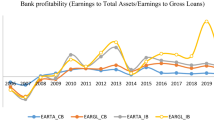Abstract
In today’s economy, the banking industry is of great importance. With the availability of new technology and the internet, more and more organizations are entering some aspect of the banking business and this results in intense competition in the financial services markets. Major domestic banks continue to pursue all the opportunities available to enhance their competitiveness. Consequently, performance analysis in the banking industry has become part of their management practices. Top bank management wants to identify and eliminate the underlying causes of inefficiencies, thus helping their firms to gain competitive advantage, or, at least, meet the challenges from others.
Access this chapter
Tax calculation will be finalised at checkout
Purchases are for personal use only
Preview
Unable to display preview. Download preview PDF.
Similar content being viewed by others
Notes
H.D. Sherman, F. Gold (1985) ‘Bank branch operating efficiency: evaluation with data envelopment analysis,’ Journal of Banking and Finance, 9 (2): 297–316;
H. Tulkens (1993) ‘On FDH efficiency analysis: some methodological issues and applications to retail banking, courts and Urban transit,’ Journal of Productivity Analysis, 4 (1/2): 183–210;
A.N. Berger, D.B. Humphrey (1997) ‘Efficiency of financial institutions: international survey and directions for future research,’ European Journal of Operational Research, 98, 175–212;
J.A. Clark (1996) ‘Economic cost, scale efficiency, and competitive viability in banking,’ Journal of Money, Banking and Credit, 28 (3): 342–364;
R. Deyoung (1997) ‘A diagnostic test for the distribution-free efficiency estimator: an example using US commercial bank data,’ European Journal of Operational Research, 98 (2): 243–249.
S.H. Wang (2003) ‘Adaptive non-parametric efficiency frontier analysis: a neuralnetwork-based model,’ Computers & Operations Research, 30: 279–295.
A.D. Athanassopoulos, S.P. Curram (1996) ‘A comparison of data envelopment analysis and artificial neural networks as tool for assessing the efficiency of decision making units,’ Journal of the Operational Research Society, 47 (8): 1000–1016.
A. Costa, R.N. Markellos (1997) ‘Evaluating public transport efficiency with neural network models,’ Transportation Research C, 5 (5): 301–312.
A.R. Fleissig, T. Kastens, D. Terrell (2000) ‘Evaluating the semi-nonparametric fourier, aim, and neural networks cost functions,’ Economics Letters, 68 (3): 235–244.
D. Santin, F.J. Delgado, A. Valino (2004) ‘The measurement of technical efficiency: a neural network approach,’ Applied Economics, 36 (6): 627–635.
P.C. Pendharkar, J.A. Rodger (2003) ‘Technical efficiency-based selection of learning cases to improve forecasting accuracy of neural networks under monotonicity assumption,’ Decision Support Systems, 36 (1): 117–136.
R.D. Banker, A. Charnes, W.W. Cooper (1984) ‘Some models for estimating technical and scale inefficiencies in data envelopment analysis,’ Management Science, 30: 1078–1092.
A. Charnes, W.W. Cooper, E. Rhodes (1978) ‘Measuring the efficiency of decision making units,’ European Journal of Operational Research, 6 (2): 429–444.
R. Hecht Nielsen (1990) ‘Neural computing,’ Addison Wesley, 124–133;
J.W. Shavlik, R.J. Mooney, G. G. Towell (1991) ‘Symbolic and neural learning algorithms: an experimental comparison,’ Machine Learning, 6: 111–143.
M.D. Troutt, A. Rai, A. Zhang (1995) ‘The potential use of DEA for credit applicant acceptance systems,’ Computers and Operations Research, 4: 405–408.
Author information
Authors and Affiliations
Copyright information
© 2015 Desheng Dash Wu and David L. Olson
About this chapter
Cite this chapter
Wu, D.D., Olson, D.L. (2015). Bank Efficiency Analysis. In: Enterprise Risk Management in Finance. Palgrave Macmillan, London. https://doi.org/10.1057/9781137466297_13
Download citation
DOI: https://doi.org/10.1057/9781137466297_13
Publisher Name: Palgrave Macmillan, London
Print ISBN: 978-1-349-69103-6
Online ISBN: 978-1-137-46629-7
eBook Packages: Palgrave Economics & Finance CollectionEconomics and Finance (R0)




